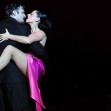
One Night Only: Tango Legends at the Sony Centre for the Performing Arts.

Tango Legends is coming directly to the Sony Centre for the Performing Arts from Argentina for a one-night only performance on Thursday, April 10 at 8:00. The show has been a critical success, with sold out audiences in Montreal and Ottawa on this their first ever Canadian tour. Its critical acclaim extended also to their recent visit to Thailand, when the dancers—14 award-winning dancers in total, a young and very talented quintet and two accomplished singers—attended the International Festival of Dance in Bangkok. They were subsequently invited to the Queen of Thailand’s 80th Birthday celebration, then Turkey and will be touring Europe in this spring. Alma Latina chatted with show producer Pablo Sosa, who along with Mariela Maldonado, founded the group and put together the show.
Lea la Versión en Español al Pie de la Página.
AL: Tell me about Tango Legends and what the group is bringing with the show. What is the intention when putting together several decades in the development of the style?
Pablo Sosa: The show is split into two parts. The first part is set in the golden age of tango, in the 40s and 50s—a time when the costumes were more elaborate and sophisticated and even the musicians were dressed in a more traditional manner. It will be a journey through several styles of dance. There are seven couples in total and every couple was selected through a gruelling audition process with a particular style and genre in mind when they were chosen. The singers are also personifying the era and at the end of the segments there’s a Carlos Gardel impersonator, with the typical image one has of Gardel, with the hat, the cane and the gloves. In the second part there’s more influence of Astor Piazzolla. Tango is divided in before and after Piazzolla, who’s the creator of several famous tangos such as Libertango and Adiós Nonino, with a bit more influence of classical music where he added percussion to the songs. At the time, in the 80s, people didn’t see that as tango. The tango purists would not accept that. In time, however, they had to because of the richness of the musical sounds. It has a little bit of that, but obviously it also includes the embrace of the tango, which is the essence and the heart of Buenos Aires. For instance, we dance Libertango in the second part, which is a Piazzolla flagship—this comes with more tricks, highs and it has a choreography. The group numbers have something called Verano Porteño, also a Piazzolla piece, without losing the passion of the music and the embrace, but is a little more modern.
AL: For audiences who, unlike native Argentineans, don’t know the history of tango, will they be able to appreciate and follow the thread of its development into what is today a worldwide known style?
Pablo Sosa: Yes. Even though this is a non-structured show, we didn’t follow a linear timeline because it would’ve been more traditional and maybe a little bit boring. We’ve tried to inject sophistication into it when we took it to the stage. The couples have a lot of ballet technical background. We’ve mixed that with the traditional embrace of tango. But every couple will be doing a different style and people will appreciate that and will really enjoy it. We’ve received very good reviews from our shows at the Terrebonne in Montreal—sold out shows—and we got standing ovations at the end of every night. The band is amazing. They’re very young, but very renowned in Buenos Aires. They’ve played with all the musical masters, and despite their young age, they’ve all carved their own musical style
AL: I’ve read that this is a very complete show (14 dancers, a quintet and two singers) and you’re the founders of the group?
Pablo Sosa: Mariela and I put this show together. We’ve worked in several other dance companies and we’ve been able to express ourselves through dance, with a show that highlights what we feel for tango, and it was very well received by all audiences. This show includes many different styles of dance. If you like traditional tango, we have that. If you like “salon” tango, we have that too. If you like modern tango, we also have that, and for those who like the passion and sensuality of the female dancer in tango—because tango has a lot of that. The best thing about tango is the woman. The costumes. The costumes were designed by Walter Delgado, who is a very well known fashion designer in Buenos Aires. There’s a lot of colour and a lot of elegance.
AL: What’s to be expected on Thursday at the Sony Centre?
Pablo Sosa: We’re a large group, seven couples in total, which is very unusual—next to impossible—for a tango show. There’s no one out there doing this. The stage will be packed with great dancers. Two singers, and normally there’s only one. The female singer has a very sweet voice. She’s very young and she feels the music and is able to transmit that to the audience. You can see it in people’s faces. This is very difficult because of the language barrier. Sometimes the sung parts are the most difficult because people don’t speak the language, but people are able to feel it. There are very well known songs like Mi Buenos Aires Querido, Ventarrón and Malena that people hear and they can identify the melody. You can see it in their expression that though they don’t understand the words, they perceive the feeling. The male singer has a very powerful and elegant voice.
AL: Canadian audiences are very open to different styles and genres and truly enjoy a good show and more often than not are very positive and enthusiastic.
Pablo Sosa: For us every performance is always our last, because we owe it to the public who buy the tickets to come and see us. They make the effort to leave their house to come and see us. Canada’s very cold and we’ve had such a good response from audiences here, with sold out shows. In Buenos Aires, for instance, with weather like this, people wouldn’t leave their house to go see a show. So we have to show some respect for the audience. There are a lot of Hispanics too. Obviously they become more emotional when seeing the show because they remember their countries or the lyrics bring back memories. When you’re outside of your country, you miss it and when they come to shows like ours, they get a feeling of nostalgia and they get really emotional.
There are still a few tickets left for Tango Legends, which you can purchase through the Sony Centre for the Performing Arts’ Box Office. Alma Latina readers can use the code Alma5 to save $5 off the ticket price. Don’t miss it. It’s in Toronto for one night only.
[envira-gallery id="5018"]
__________________________
Pablo Sosa: Pablo Sosa: Si. Si bien es un espectáculo atemporal, porque no respetamos rigurosamente la época porque si no la primer parte tendría que ser un poco más tradicional y se tornaría digamos aburrido. Le hemos metido sofisticación al show. Lo hemos llevado al escenario. Las parejas tienen muchas técnicas de ballet. Hemos mezclado lo que es la técnica de ballet con la pasión del abrazo del tango. Pero cada pareja hace un estilo diferente de baile, asi que la gente lo van a apreciar muy bien y van a estar muy conformes y muy contentos. Ya venimos teniendo buenas críticas de lo que fue Terrebonne en Montreal, con las salas llenas y la gente nos despidió de pie en todos los espectáculos. La orquesta toca muy bien. Son jóvenes músicos, muy reconocidos en Buenos Aires y ya han tocado con los grandes maestros. Con la corta edad que tienen, ya han formado su propio estilo.
AL: Que puede esperar el publico este Jueves en el Sony Centre?
Pablo Sosa: Somos un grupo muy grande, somos 7 parejas de baile, lo cual en un show de tango hoy en día es imposible. No hay ninguna compañía que hoy en día esté girando con 7 parejas de baile. Ustedes van a ver un escenario muy lleno de bailarines. Dos cantores, que por lo general siempre llevan un cantor. La cantora femenina tiene una voz muy dulce, muy jovencita y la verdad siente el tango y lo transmite al público. Se le ve en la cara a la gente. Asi es muy difícil a veces por el idioma. A veces lo más difícil es la parte cantada porque hay muy pocos países de habla hispana donde hemos ido, pero se ve que a la gente le hace sentir. Hay temas muy conocidos como Mi Buenos Aires Querido, Ventarrón, Malena– que uno ya escucha la melodía y la identifican. Se le ve en la cara a la gente que talvez no entienden la letra, pero perciben el sentimiento con el que uno lo está realizando. Y el cantor masculino, pues bueno, tiene una voz muy imponente y muy elegante.
AL: El público Canadiense es bastante abierto a los diferentes estilos y géneros de baile y realmente disfrutan de un buen espectáculo, y con mucha frecuencia son muy positivos y entusiastas cuando vienen a ver un show de otro país de origen.
Pablo Sosa: Para nosotros cada show siempre es el último porque le debemos un respeto al público que compra el ticket para venir a vernos, que es un esfuerzo, que sale de su casa. Además hace mucho frío en Canadá y la verdad hemos tenido muy buena respuesta con los teatros llenos. Por ejemplo, con estas temperaturas en Buenos Aires la gente sale muy poco al teatro. Entonces le debemos ese respeto al público, no? Hay mucha audiencia latina tambien. Obviamente que el latino siempre se emociona más porque le hace recordar un poco a su tierra ó en las letras de los temas. Cuando uno está fuera de su país, se extraña y cuando vienen espectáculos que le hacen recordar un poco su tierra, se emocionan muchísimo.Todavia quedan unos cuantos boletos para ir a ver Tango Legends (Las Leyendas del Tango), las cuales pueden comprar en la taquilla del Sony Centre for the Performing Arts. Los lectores de Alma Latina pueden usar el codigo Alma5 para ahorrar $5 del precio de cada boleto. No se lo pierdan, ya que estara en Toronto por solamente una noche.

















Leave a Reply